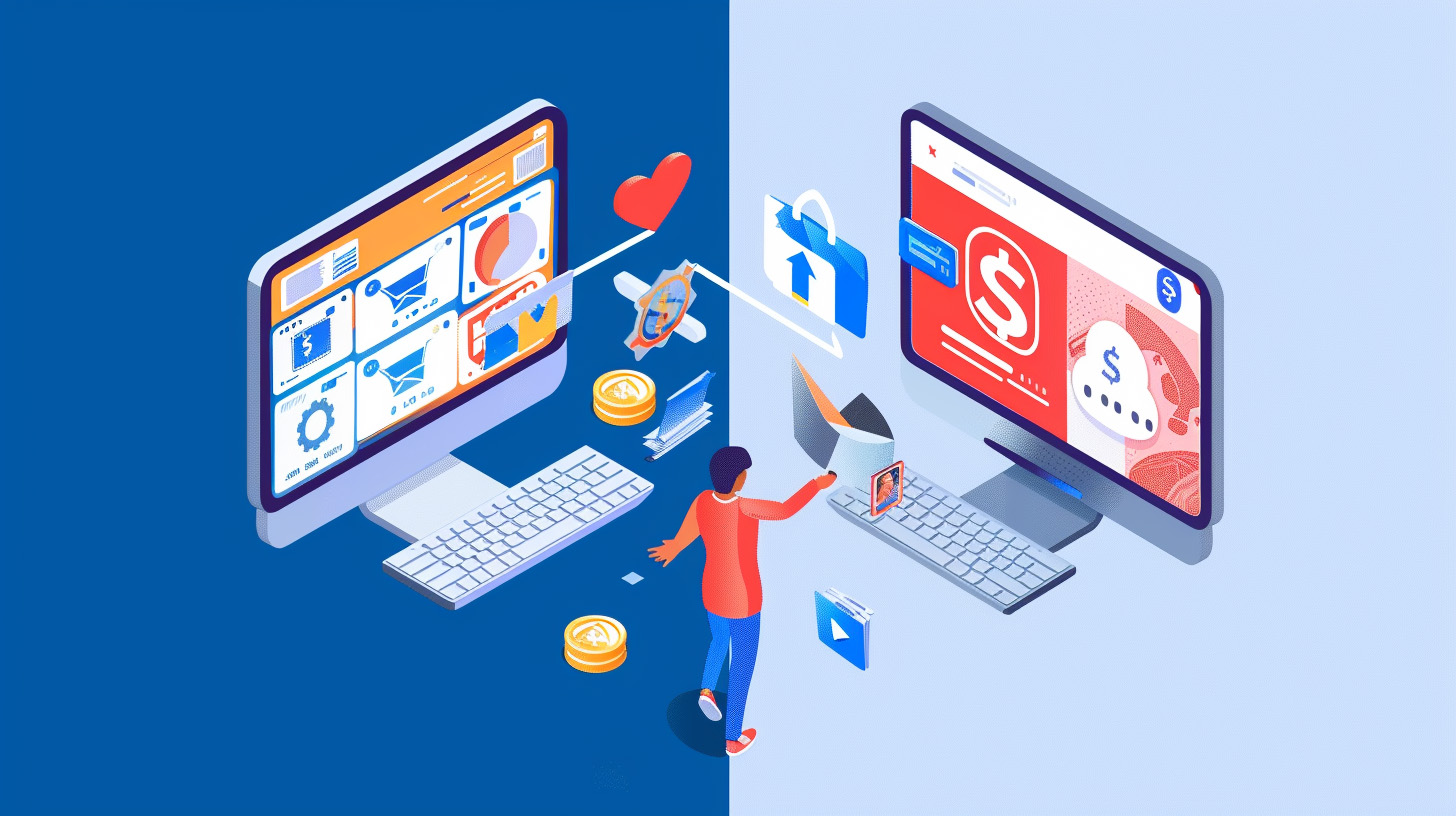Affiliate marketing has become an increasingly popular way for digital marketers to earn a passive income online. By promoting products or services and earning a commission on each sale, affiliate marketers can build a profitable business from the comfort of their own homes.
However, not all affiliate marketing programs are created equal. One key distinction is between high-ticket and low-ticket affiliate marketing. Understanding the differences between these two approaches is important for anyone looking to succeed in the world of affiliate marketing.
What is High-Ticket Affiliate Marketing?
High-ticket affiliate marketing is a form of affiliate marketing that focuses on promoting and selling high-priced products or services, typically those with a price point of $500 or more. In this business model, affiliate marketers earn substantial commissions for each successful sale they generate, often ranging from a few hundred to several thousand dollars per transaction.
Unlike traditional affiliate marketing, which involves promoting low-ticket items and earning small commissions on a high volume of sales, high-ticket affiliate marketing allows marketers to generate significant income from fewer sales. This is because the commission rates for high-ticket products are generally much higher, often between 10% to 50% of the product’s price.
High-ticket affiliate marketing typically involves promoting digital products, such as online courses, software, and membership programs, as well as high-end physical products like luxury goods, electronics, and machinery. These high-ticket items are often targeted towards a specific niche audience that is willing to invest in premium solutions to their problems or desires.
To succeed in high-ticket affiliate marketing, marketers need to focus on building trust and credibility with their audience. This involves creating high-quality content, such as blog posts, videos, podcasts, and webinars, that educate potential customers about the products and demonstrate their value. Marketers also need to develop effective sales funnels and use various marketing channels, such as email marketing, social media, and paid advertising, to reach and convert their target audience.
Pros of High-Ticket Affiliate Marketing
Higher commissions per sale
One of the most significant advantages of high-ticket affiliate marketing is the potential to earn high commissions on each sale. While low-ticket affiliate programs typically offer commissions ranging from a few dollars to a few dozen dollars, high-ticket affiliate programs can pay out hundreds or even thousands of dollars per sale—a lot of money.
Potential for passive income with fewer sales
Because of the higher affiliate commission rates associated with high-ticket sales, marketers can achieve their income goals with a lower volume of sales. This can lead to a more passive income stream, as affiliates can focus on promoting a select few high-quality products rather than constantly chasing new sales.
By building a targeted audience and creating evergreen content that promotes high-ticket items, affiliates can enjoy a more stable and predictable income.
Attracting a more targeted and committed audience
High-ticket affiliate products often appeal to a specific niche audience that is willing to invest in premium solutions. These customers are typically more committed to achieving their goals and are less likely to be swayed by cheaper alternatives.
By focusing on high-ticket items, affiliates can attract a more targeted and engaged audience that is more likely to make a purchase and remain loyal to the brand.
Cons of High-Ticket Affiliate Marketing
Longer sales cycle and more effort required to convert leads
One of the main drawbacks of high-ticket affiliate marketing is the longer sales cycle involved. Because of the high price points, potential customers often require more time and information before making a purchase decision.
This means that affiliates need to invest more effort in nurturing leads, providing valuable content, and building trust with their audience.
Higher competition for high-ticket affiliate products
As more affiliates recognize the potential for substantial earnings in high-ticket affiliate marketing, the competition for promoting these products has increased. Many experienced marketers with established audiences and significant resources are vying for the same customer base, making it harder for newcomers to gain traction.
This intense competition can lead to higher advertising costs and lower conversion rates, especially for those just starting in the high-ticket affiliate space.
Requires a well-established online presence and authority
To successfully promote high-ticket affiliate products, marketers often need to have a strong online presence and a reputation as an authority in their niche. Potential customers are more likely to trust recommendations from well-known and respected figures, particularly when considering expensive purchases.
Building this level of authority and credibility can take significant time and effort.
Potential for higher refund rates
Given the substantial investment required for high-ticket products, customers may be more likely to request refunds if they are unsatisfied with their purchase. This can lead to a higher refund rate compared to low-ticket items, which can impact an affiliate’s earnings and reputation.
To mitigate this risk, affiliates must carefully select the products they promote, ensuring they are of high quality and value to their audience.
Dependence on the advertiser’s performance and commitment
In high-ticket affiliate marketing, the affiliate’s earnings are closely tied to the advertiser’s website conversion rate and overall performance. If the advertiser’s site fails to convert well or the product quality is subpar, even a high volume of traffic may not result in significant commissions for the affiliate.
Additionally, affiliates are reliant on the advertiser’s ongoing commitment to the affiliate program. Changes in terms, commission rates, or the discontinuation of the program can have a substantial impact on an affiliate’s income.
High-ticket sales needs high-risk solutions. We can help.

What is Low-Ticket Affiliate Marketing?
Low-ticket affiliate marketing involves promoting and earning commissions from the sale of relatively inexpensive products or services, typically priced under $300. Unlike high-ticket affiliate marketing, which focuses on high-priced offerings, low-ticket affiliate marketing revolves around promoting lower-cost items that are more accessible to a broader audience.
In terms of pricing, low-ticket items generally fall within the range of $1 to $100. Examples of such products include home goods, clothing, accessories, beauty products, electronics, and other consumer goods. For digital products, such as ebooks, software, or online courses, the price range is the same.
One of the key characteristics of low-ticket affiliate marketing is the lower commission rates offered by merchants.
Despite the lower amount of money from commission rates, low-ticket affiliate marketing can still be a profitable endeavor for marketers. The low price points of these products often lead to higher conversion rates and a higher volume of sales. By promoting a diverse range of low-ticket products and leveraging various marketing channels, such as social media, email marketing, and search engine optimization (SEO), affiliates can generate a steady stream of commissions that can accumulate over time.
Pros of Low-Ticket Affiliate Marketing
Lower barrier to entry for beginners
One of the primary advantages of low-ticket affiliate marketing is its accessibility for those new to the industry. With lower product prices and commission rates, the financial risk is minimized, making it an ideal starting point for beginners to gain experience and build their affiliate marketing skills.
Easier to generate sales and build momentum
Low-ticket products often have a lower perceived risk for potential customers, leading to higher conversion rates and more frequent sales. This can be particularly beneficial for affiliates who are just starting to build their audience and online presence.
Potential for high volume of sales
While individual commissions may be lower for low-ticket products, the potential for a high volume of sales can compensate for this. By promoting a diverse range of low-ticket items across various niches and leveraging effective marketing strategies, affiliates can accumulate multiple small commissions that can add up to a significant income over time.
Opportunities for upselling and cross-selling
Low-ticket affiliate marketing can serve as an entry point for customers, allowing affiliates to build relationships and trust. Once a customer has made an initial low-ticket purchase, affiliates can leverage this relationship to upsell or cross-sell complementary products or higher-priced offerings, potentially leading to increased revenue and customer lifetime value.
Broader appeal and impulse purchases
Low-ticket products often have a broader appeal due to their affordability. This can make them more suitable for impulse purchases, where customers are more likely to make spontaneous buying decisions without extensive research or deliberation.
Affiliates can capitalize on this by promoting low-ticket items through various channels, such as social media and email marketing, to capture these impulse buyers.
Cons of Low-Ticket Affiliate Marketing
Lower commission rates per sale
One of the primary drawbacks of low-ticket affiliate marketing is the lower commission rates offered by merchants. While high-ticket products can provide commissions ranging from 10% to 50% or higher, low-ticket affiliate programs typically offer commission rates between 1% and 5%.
This lower commission rate is due to the lower profit margins associated with inexpensive products and the additional costs involved in manufacturing, marketing, and distributing physical goods.
Requires a larger volume of sales to generate significant income
Because of the lower commission rates, affiliates need to generate a higher volume of sales to achieve substantial earnings from low-ticket affiliate marketing. This can be time-consuming and may require more effort in terms of marketing and promotion to drive consistent traffic and conversions.
Can be more time-consuming to manage multiple low-ticket products
To compensate for the lower commissions per sale, affiliates often need to promote a diverse range of low-ticket products across various niches. Managing multiple product lines, tracking inventory, and staying up-to-date with promotions and offers can be more time-consuming compared to focusing on a few high-ticket products.
Potential for lower-quality products or offers
While there are many reputable low-ticket affiliate programs, some merchants may offer lower-quality products or services to keep costs down. This can lead to higher return rates, dissatisfied customers, and potential damage to the affiliate’s reputation if they promote subpar products.
Limited potential for passive income
Low-ticket affiliate marketing often requires more active promotion and marketing efforts to generate consistent sales. Unlike high-ticket products, where a single sale can result in a substantial commission, low-ticket affiliates may need to continuously promote and drive traffic to maintain their income stream.
Increased competition and market saturation
Due to the lower barrier to entry, the low-ticket affiliate marketing space can be highly competitive and saturated. Affiliates may face challenges in standing out and differentiating their offerings, especially when promoting popular consumer products or services.
Did you know affiliate marketing is a high-risk industry?

Promoting High-Ticket vs Low-Ticket Affiliate Products
When it comes to promoting high-ticket and low-ticket affiliate products, the strategies and approaches can differ significantly. Here’s a breakdown of how to effectively promote each type of product.
Promoting High-Ticket Affiliate Products
- Webinars and Live Events: High-ticket products often require more education and nurturing of potential customers. Hosting webinars or live events can be an effective way to showcase the value of the product, address objections, and build trust with your audience.
- Email Marketing: A well-crafted email marketing campaign is crucial for promoting high-ticket offers. You can use email sequences to warm up your audience, provide valuable content, and eventually pitch the high-ticket product.
- Search Engine Optimization (SEO): Optimizing your content for relevant keywords can help attract potential customers who are actively searching for solutions related to your high-ticket product. By ranking well in search engines, you can establish authority and credibility in your niche.
- Influencer Marketing: Partnering with influencers, bloggers, or industry experts can lend credibility to your high-ticket product promotion. Their endorsement and social proof can be powerful in convincing potential customers to invest in your high-priced offering.
- Retargeting and Remarketing: High-ticket products often require multiple touchpoints before a purchase decision is made. Retargeting and remarketing campaigns can help keep your offer top-of-mind for potential customers who have shown interest but haven’t yet converted.
Promoting Low-Ticket Affiliate Products
- Social Media Marketing: Low-ticket products are often well-suited for social media promotion, as they can be easily shared and promoted to a broad audience. Platforms like Facebook, Instagram, and TikTok can be effective for driving impulse purchases and generating buzz around low-ticket offers.
- Email List Building: While email marketing is also important for low-ticket products, the focus should be on building a large and engaged email list. By offering lead magnets or free resources, you can attract potential customers and promote your low-ticket offers to a wider audience.
- Sales Funnels: Creating sales funnels can be an effective way to promote low-ticket products. By offering a low-cost entry point, you can then upsell or cross-sell complementary products or services to your customers.
- Content Marketing: Producing high-quality, informative content related to your low-ticket products can help attract organic traffic and establish your authority in your niche. Blog posts, videos, and podcasts can all be effective content marketing strategies.
- Affiliate Partnerships: Partnering with other types of affiliates or influencers in your niche can help you reach a wider audience and promote your low-ticket products more effectively. Reciprocal promotion and cross-promotion can be mutually beneficial.

Combining High-Ticket and Low-Ticket Affiliate Marketing
While high-ticket and low-ticket affiliate marketing have their distinct advantages and challenges, many successful affiliates have found that combining both approaches can be a powerful strategy for maximizing their income potential and building a well-rounded ecommerce retail business.
Benefits of promoting both high and low-ticket affiliate products
- Diversification: By offering a mix of high-ticket and low-ticket products, you can diversify your income streams and reduce reliance on any single product or niche.
- Broader audience appeal: High-ticket products cater to a more targeted, committed audience, while low-ticket items have a broader appeal, allowing you to reach a wider range of potential customers.
- Upselling and cross-selling opportunities: Low-ticket products can serve as an entry point for customers, allowing you to build trust and relationships before introducing higher-priced offerings through upselling and cross-selling strategies.
Creating a balanced affiliate marketing portfolio:
- Identify complementary high-ticket and low-ticket products within your niche or related niches.
- Allocate resources and marketing efforts strategically, focusing on high-ticket products for their potential for substantial commissions and low-ticket products for their volume and accessibility.
- Continuously evaluate and adjust your product mix based on performance, market trends, and customer demand.
Using low-ticket products as a gateway to high-ticket offers:
- Offer low-ticket products as an initial entry point to build trust and credibility with your audience.
- Provide exceptional value and support for low-ticket customers, nurturing them through the customer journey.
- Introduce high-ticket products as natural upsells or complementary offerings, leveraging the trust and relationships you’ve built.
Maximizing your income potential with a diversified approach:
- Leverage the strengths of both high-ticket and low-ticket affiliate marketing to create multiple income streams.
- Reinvest profits from low-ticket sales into scaling your high-ticket promotions and vice versa, creating a self-sustaining cycle of growth.
- Continuously optimize your marketing strategies, sales funnels, and product offerings based on data and customer feedback.
By combining high-ticket and low-ticket affiliate marketing, you can create a well-rounded and sustainable online business model. This diversified approach allows you to cater to different customer segments, leverage various marketing strategies, and maximize your income potential while mitigating the risks associated with relying solely on one product type or income stream.









